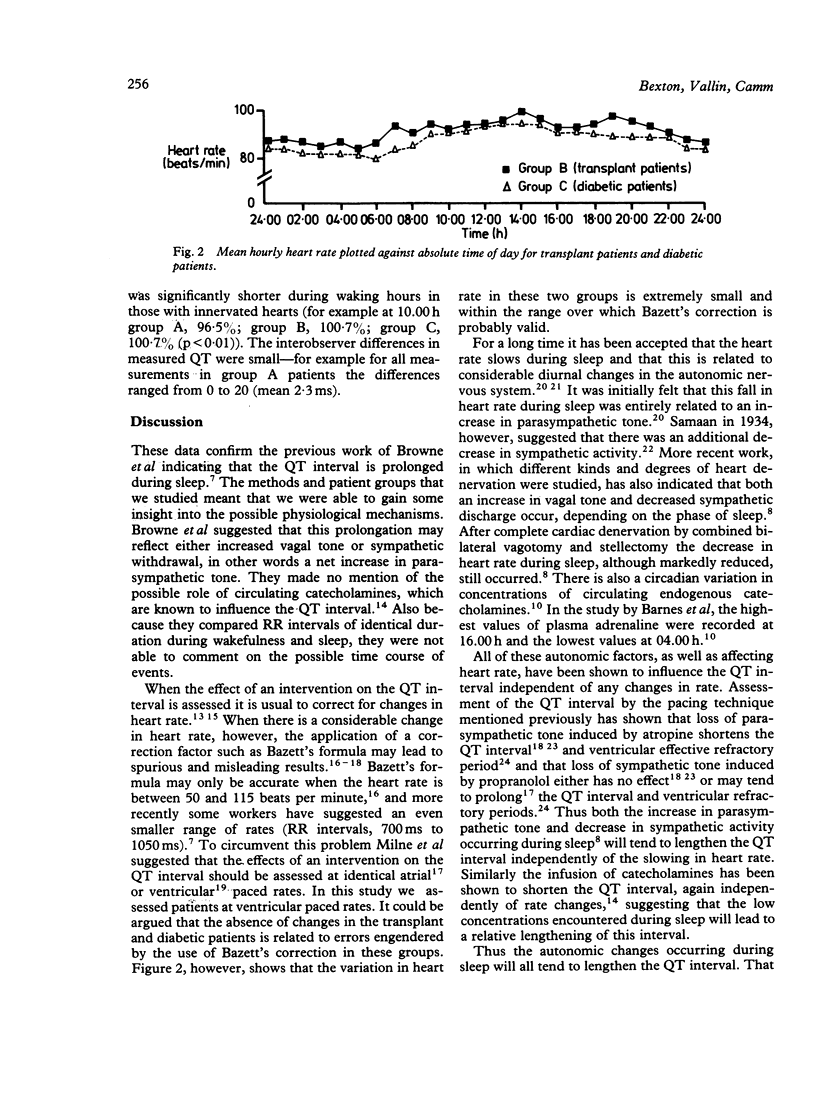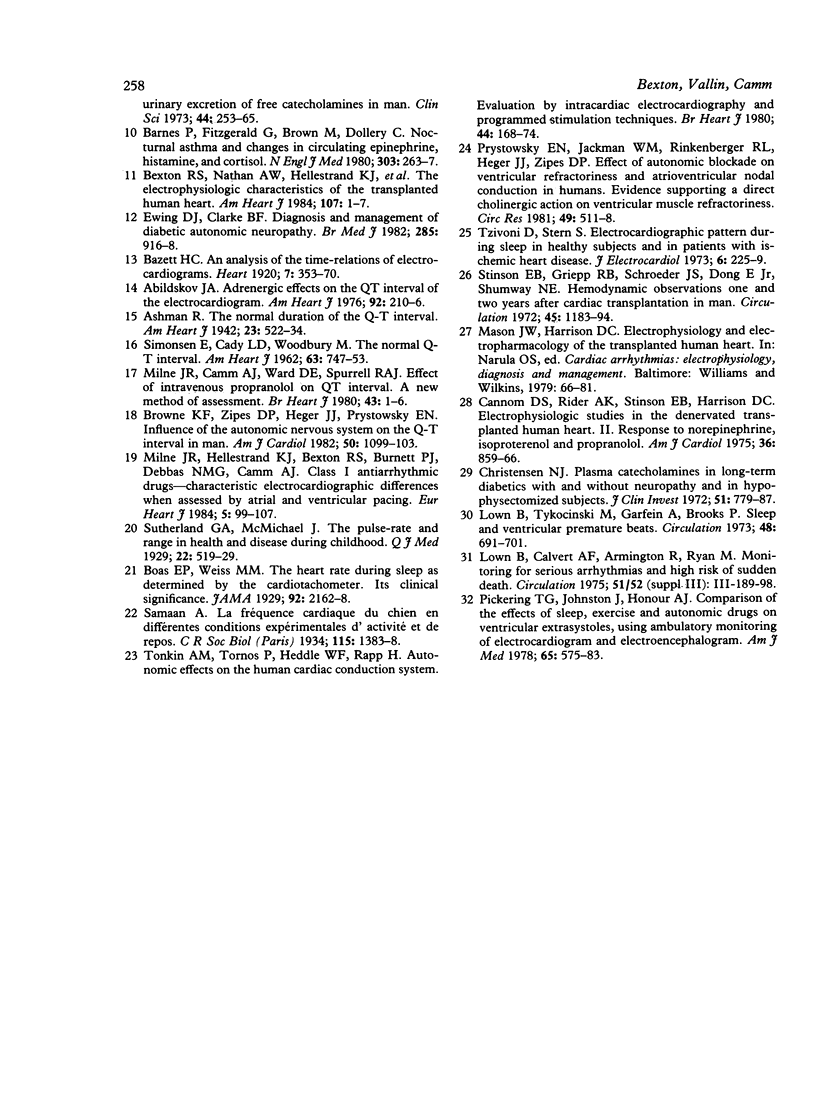Abstract
To assess the influence of diurnal changes in the autonomic nervous system on the QT interval, 24 hour dynamic electrocardiographic monitoring was performed in six pacemaker dependent patients with normally innervated hearts, in six cardiac transplant patients with anatomically denervated hearts (but which respond to circulating catecholamines), and in nine diabetic patients with confirmed autonomic neuropathy. QT and RR intervals from hourly intervals were measured and Bazett's formula was used to correct QT intervals during sinus rhythm. All QT intervals were normalised by dividing by the mean QT for the 24 hours in each patient and were expressed as a percentage. There was pronounced diurnal variation of normalised QT in the patients with normally innervated hearts. QT intervals were longer during sleep than during waking hours (06.00 vs 18.00 h, 102.5% vs 97.8%). Diurnal variation was blunted in the transplant patients (101.3% vs 98.1%) and absent in the diabetic patients (100.0% vs 100.3%). In the normally innervated patients changes were most pronounced at the time of waking (06.00 vs 09.00 h, 102.5% vs 95.4%). There was no change in normalised QT in the transplant and diabetic patients at this time. There was no significant difference between normalised QT for the three groups during sleep, but this variable was shorter in innervated patients during waking hours (for example at 10.00 h, innervated 96.5%, transplant 100.7%, diabetic 100.7%). Diurnal changes of the QT interval may be pronounced in the innervated heart and are dependent on both variations in autonomic tone and concentrations of circulating catecholamines. These changes in repolarisation may be related to the reported diurnal pattern of ventricular arrhythmias.
Full text
PDF





Selected References
These references are in PubMed. This may not be the complete list of references from this article.
- Abildskov J. A. Adrenergic effects of the QT interval of the electrocardiogram. Am Heart J. 1976 Aug;92(2):210–216. doi: 10.1016/s0002-8703(76)80256-6. [DOI] [PubMed] [Google Scholar]
- Ahnve S., Helmers C., Lundman T., Rehnqvist N., Sjögren A. QTc intervals in acute myocardial infarction: first-year prognostic implications. Clin Cardiol. 1980 Oct;3(5):303–308. doi: 10.1002/clc.4960030403. [DOI] [PubMed] [Google Scholar]
- Barnes P., FitzGerald G., Brown M., Dollery C. Nocturnal asthma and changes in circulating epinephrine, histamine, and cortisol. N Engl J Med. 1980 Jul 31;303(5):263–267. doi: 10.1056/NEJM198007313030506. [DOI] [PubMed] [Google Scholar]
- Baust W., Bohnert B. The regulation of heart rate during sleep. Exp Brain Res. 1969;7(2):169–180. doi: 10.1007/BF00235442. [DOI] [PubMed] [Google Scholar]
- Browne K. F., Prystowsky E., Heger J. J., Chilson D. A., Zipes D. P. Prolongation of the Q-T interval in man during sleep. Am J Cardiol. 1983 Jul;52(1):55–59. doi: 10.1016/0002-9149(83)90068-1. [DOI] [PubMed] [Google Scholar]
- Browne K. F., Zipes D. P., Heger J. J., Prystowsky E. N. Influence of the autonomic nervous system on the Q-T interval in man. Am J Cardiol. 1982 Nov;50(5):1099–1103. doi: 10.1016/0002-9149(82)90425-8. [DOI] [PubMed] [Google Scholar]
- Cannom D. S., Rider A. K., Stinson E. B., Harrison D. C. Electrophysiologic studies in the denervated transplanted human heart. II. Response to norepinephrine, isoproterenol and propranolol. Am J Cardiol. 1975 Dec;36(7):859–866. doi: 10.1016/0002-9149(75)90074-0. [DOI] [PubMed] [Google Scholar]
- Christensen N. J. Plasma catecholamines in long-term diabetics with and without neuropathy and in hypophysectomized subjects. J Clin Invest. 1972 Apr;51(4):779–787. doi: 10.1172/JCI106872. [DOI] [PMC free article] [PubMed] [Google Scholar]
- Ewing D. J., Clarke B. F. Diagnosis and management of diabetic autonomic neuropathy. Br Med J (Clin Res Ed) 1982 Oct 2;285(6346):916–918. doi: 10.1136/bmj.285.6346.916. [DOI] [PMC free article] [PubMed] [Google Scholar]
- JERVELL A., LANGE-NIELSEN F. Congenital deaf-mutism, functional heart disease with prolongation of the Q-T interval and sudden death. Am Heart J. 1957 Jul;54(1):59–68. doi: 10.1016/0002-8703(57)90079-0. [DOI] [PubMed] [Google Scholar]
- Lown B., Tykocinski M., Garfein A., Brooks P. Sleep and ventricular premature beats. Circulation. 1973 Oct;48(4):691–701. doi: 10.1161/01.cir.48.4.691. [DOI] [PubMed] [Google Scholar]
- Milne J. R., Camm A. J., Ward D. E., Spurrell R. A. Effect of intravenous propranolol on QT interval. A new method of assessment. Br Heart J. 1980 Jan;43(1):1–6. doi: 10.1136/hrt.43.1.1. [DOI] [PMC free article] [PubMed] [Google Scholar]
- Milne J. R., Hellestrand K. J., Bexton R. S., Burnett P. J., Debbas N. M., Camm A. J. Class 1 antiarrhythmic drugs--characteristic electrocardiographic differences when assessed by atrial and ventricular pacing. Eur Heart J. 1984 Feb;5(2):99–107. doi: 10.1093/oxfordjournals.eurheartj.a061633. [DOI] [PubMed] [Google Scholar]
- Pickering T. G., Johnston J., Honour A. J. Comparison of the effects of sleep, exercise and autonomic drugs on ventricular extrasystoles, using ambulatory monitoring of electrocardiogram and electroencephalogram. Am J Med. 1978 Oct;65(4):575–583. doi: 10.1016/0002-9343(78)90844-6. [DOI] [PubMed] [Google Scholar]
- Prystowsky E. N., Jackman W. M., Rinkenberger R. L., Heger J. J., Zipes D. P. Effect of autonomic blockade on ventricular refractoriness and atrioventricular nodal conduction in humans. Evidence supporting a direct cholinergic action on ventricular muscle refractoriness. Circ Res. 1981 Aug;49(2):511–518. doi: 10.1161/01.res.49.2.511. [DOI] [PubMed] [Google Scholar]
- ROMANO C., GEMME G., PONGIGLIONE R. ARITMIE CARDIACHE RARE DELL'ETA' PEDIATRICA. II. ACCESSI SINCOPALI PER FIBRILLAZIONE VENTRICOLARE PAROSSISTICA. (PRESENTAZIONE DEL PRIMO CASO DELLA LETTERATURA PEDIATRICA ITALIANA) Clin Pediatr (Bologna) 1963 Sep;45:656–683. [PubMed] [Google Scholar]
- SIMONSON E., CADY L. D., Jr, WOODBURY M. The normal Q-T interval. Am Heart J. 1962 Jun;63:747–753. doi: 10.1016/0002-8703(62)90059-5. [DOI] [PubMed] [Google Scholar]
- Schwartz P. J., Wolf S. QT interval prolongation as predictor of sudden death in patients with myocardial infarction. Circulation. 1978 Jun;57(6):1074–1077. doi: 10.1161/01.cir.57.6.1074. [DOI] [PubMed] [Google Scholar]
- Stinson E. B., Griepp R. B., Schroeder J. S., Dong E., Jr, Shumway N. E. Hemodynamic observations one and two years after cardiac transplantation in man. Circulation. 1972 Jun;45(6):1183–1194. doi: 10.1161/01.cir.45.6.1183. [DOI] [PubMed] [Google Scholar]
- Tonkin A. M., Tornos P., Heddle W. F., Rapp H. Autonomic effects on the human cardiac conduction system. Evaluation by intracardiac electrocardiography and programmed stimulation techniques. Br Heart J. 1980 Aug;44(2):168–174. doi: 10.1136/hrt.44.2.168. [DOI] [PMC free article] [PubMed] [Google Scholar]
- Townshend M. M., Smith A. J. Factors influencing the urinary excretion of free catecholamines in man. Clin Sci. 1973 Mar;44(3):253–265. doi: 10.1042/cs0440253. [DOI] [PubMed] [Google Scholar]
- Tzivoni D., Stern S. Electrocardiographic pattern during sleep in healthy subjects and in patients with ischemic heart disease. J Electrocardiol. 1973;6(3):225–230. doi: 10.1016/s0022-0736(73)80037-8. [DOI] [PubMed] [Google Scholar]
- WARD O. C. A NEW FAMILIAL CARDIAC SYNDROME IN CHILDREN. J Ir Med Assoc. 1964 Apr;54:103–106. [PubMed] [Google Scholar]


